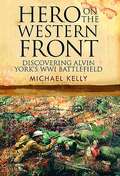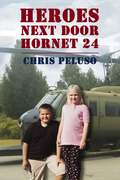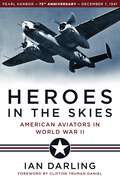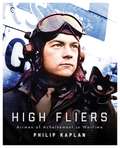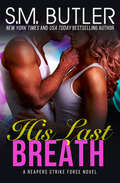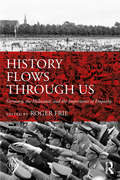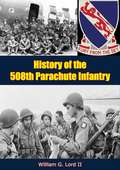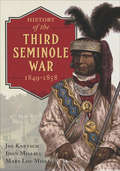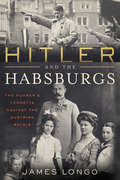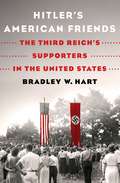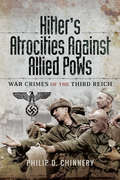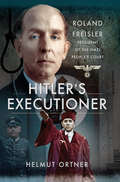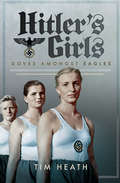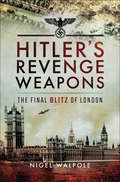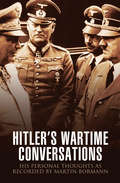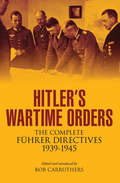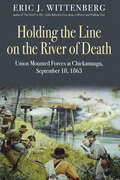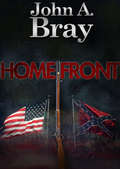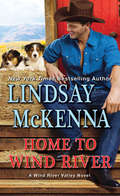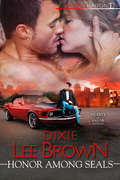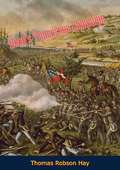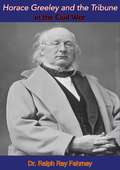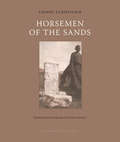- Table View
- List View
Hero On the Western Front: Discovering Alvin C. York's Great War Battlefield
by Michael KellyThey knew it was the end. Weakened by four years of war, the reality had finally dawned on the Germans that their armies could never stop the combined might of the Allied forces, now bolstered by the fresh, enthusiastic Americans, who were now determined to be involved in the conflict that had engulfed the world.
Heroes Next Door: Hornet 24
by Chris PelusoWritten to help address the dearth of age appropriate material focusing on the Vietnam conflict, Heroes Next Door – Hornet 24 gives the middle school and young adult reader a window into the lives of helicopter pilots during that conflict. The book is written with attention to detail, the reader experiences basic training, flight school, and twelve months of life, service, and sacrifice in Vietnam as told by a veteran who lives next door. Matt and Ellie are growing up in an average suburban area, when their next-door shows up with an olive-drab painted Army helicopter. The machinery sparks immediate interest and serves as a conduit to relationship building between the two children and their neighbor, Mr. Ed. Spread over nearly two years the siblings help restore the vintage aircraft and gradually, Mr. Ed shares stories of his training and experiences during the 1960s. Stories from Basic Training gives the reader a sense of the discipline and focus required. Flight training introduces the reader to some of the principles of helicopter flight and performance. Readers travel the globe, landing in Southeast Asia just after the Tet Offensive. The risk, fears, apprehensions, and personal development that come with such a deployment, along with the emotional growth, team building, and camaraderie weave into a series of combat action sequences. The reader is left with a basic understanding of the history of the conflict (thru late 1969), how U.S. and South Vietnamese troops engaged and searched for the communist forces, and how helicopters provided maneuverability and flexibility to the U.S. forces. Along the way, the reader is shown life in a large Army camp, Saigon, and the risks associated with assignment to Vietnam. Heroes Next Door-Hornet 24 also shows some of the lighter side of the conflict, rest and rehab in Bangkok, recreation in camp, team building, and a few current events. It also takes a brief look at the anti-war movement and how it affected the soldiers who were doing their duty. Heroes Next Door -Hornet 24 is a unique book that reveals the humanity and the horrors of the Vietnam War in a manner that is appropriate for younger audiences. With attention to historical accuracy and touching respect for the men and women of the Vietnam War, this book is a must-have companion for any young reader looking for real-life heroes.
Heroes in the Skies: American Aviators in World War II
by Ian DarlingPublished to coincide with the 75th anniversary of the attack on Pearl Harbor, these gripping true stories capture the astonishing bravery of the fliers who helped win World War II. American pilots fought fierce and often deadly battles in every theater of war, and many overcame incredible obstacles to survive. Meet some of these courageous aviators, including George McGovern, who survived enemy fire that left 110 holes in his aircraft; George H. W. Bush, shot down in the Pacific; Jim Landis, a naval flyer stationed in Pearl Harbor who returned fire even after sustaining a bullet through his hand; Alex Jefferson, a Tuskegee airman shot down over France and taken prisoner; and Betty Blake, one of the little-known women pilots who aided the war effort. Clifton Truman Daniel, a grandson of President Truman, provides the foreword to this collection of carefully researched and vividly told profiles in courage that will transport you to the bullet-ridden, bomb-laden skies of the early 1940s.
High Fliers: Airmen of Achievement in Wartime
by Philip KaplanThere were two kinds of pilots involved in the action during the Second World War: those who took the lead, and the others who went along for the ride. The elite group of fighter and bomber pilots led the way in combat missions, racking up kills and destroying the enemy?s ability to fight. Experience was a big factor; the fliers who had been around the longest (and survived) learned all the tricks and made the most of that knowledge. They created expressions to help them stay alive and succeed in the unique arena of air combat and ways to win and succeed in situations when many of their colleagues did not. Reminders such as ?Beware of the Hun in the Sun? and ?Check Six? were meaningful warnings in air fighting and still are. ?Situational awareness? about the flying and fighting environment was ingrained in the great air fighters. One of the greatest of the high-achieving fighter pilots of WWII was Adolph ?Sailor? Malan, the legendary ace who set the standard for Allied pilots. He developed what he called Ten of My Rules for Air Fighting, which included points like ?Always turn and face the attack,? ?Never fly straight and level for more than thirty seconds in the combat area,? and ?Go in quickly?punch hard?Get out!? High Fliers recounts the wartime careers of the pilots who used determination, intelligence, guts, and skill to find victory in the air.
His Last Breath (Reapers Strike Force #1)
by S. M. ButlerThe Reapers aren't exactly what they seem. They're the most elite of the world's fighters--but all they have in common is that their countries and their families can never know that they exist. Christopher Hardy has spent the last two years in self-imposed exile with a team he built from the ground up. A former SEAL, he was medically discharged after a near-death experience. But a brand-new procedure made him whole again and now his mission is to save the world or die trying. There's no room in there for love, not to mention it's against the rules. Abigail Lewis hasn't seen Chris since the day he rescued her five years ago. He's changed, grown darker and more dangerous than she remembers, but somehow that just seems to make him even sexier. But Chris is a high-risk heartache waiting to happen, and she's got bigger problems to worry about, like not getting murdered. Every moment they spend together becomes more and more incendiary, both for their lives and their hearts. Trust doesn't come easy and secrets have a way of getting out when you least expect it.
History Flows through Us: Germany, the Holocaust, and the Importance of Empathy
by Roger FrieHistory Flows through Us introduces a new dialogue between leading historians and psychoanalysts and provides essential insights into the nature of historical trauma. The contributors – German historians, historians of the Holocaust and psychoanalysts of different disciplinary backgrounds – address the synergy between history and psychoanalysis in an engaging and accessible manner. Together they develop a response to German history and the Holocaust that is future-oriented and timely in the presence of today’s ethnic hatreds. In the process, they help us to appreciate the emotional and political legacy of history’s collective crimes. This book illustrates how history and the psyche shape one another and the degree to which history flows through all of us as human beings. Its innovative cross-disciplinary approach draws on the work of the historian and psychoanalyst Thomas Kohut. The volume includes an extended dialogue with Kohut in which he reflects on the study of German history and the Holocaust at the intersection of history and psychoanalysis. This book demonstrates that the fields of history and psychoanalysis are each concerned with the role of empathy and with the study of memory and narrative. History Flows through Us will appeal to general readers, students and professionals in cultural history, Holocaust and trauma studies, sociology, psychoanalysis, psychotherapy and psychology.
History of the 508th Parachute Infantry
by William G. Lord IIThe 508th Parachute Infantry Regiment was an airborne infantry regiment of the United States Army, first formed in October 1942 during World War II at Camp Blanding, Florida by Lieutenant-Colonel Roy E. Lindquist, who would remain its commander throughout the war.The 508th Parachute Infantry Regiment participated in Operation Overlord, jumping into Normandy at 2:15 a.m. on 6 June 1944, and was awarded the Distinguished Unit Citation for its gallantry and combat action during the first three days of fighting.The Regiment also saw active service in Operation Market Garden in the Netherlands, jumping on 17 September 1944, and continued fighting the Germans in the longest-running battle on German soil ever fought by the U.S. Army, before crossing the border into Belgium.They played a major part in the Battle of the Bulge in late December 1944, during which they screened the withdrawal of some 20,000 troops from St. Vith, defended their positions against the German Panzer divisions, and participated in the assault led by the 2nd Ranger Battalion to capture (successfully) Hill 400.U.S. D-Day paratrooper William G. Lord II’s History of the 508th Parachute Infantry Regiment, which was originally published in 1948, provides an extensive and fascinating chronicle for the period from October 20, 1942 to January 1, 1946, and will appeal to discerning World War II historians and scholars alike.Richly illustrated throughout with photographs and maps, this volume also includes in its appendix a list of combat awards, unit citations, and battle casualties.
History of the Third Seminole War, 1849–1858: 1849-1858
by Joe Knetsch John Missall Mary Lou MissallThis definitive account of the final war between the US government and Florida&’s Seminole tribe &“brings to life a conflict that is largely ignored&” (San Francisco Book Review). Spanning a period of over forty years (1817–1858), the three Seminole Wars were America&’s longest, costliest, and deadliest Indian wars, surpassing the more famous ones fought in the West. After an uneasy peace following the conclusion of the second Seminole War in 1842, a series of hostile events, followed by a string of murders in 1849 and 1850, made confrontation inevitable. The war was also known as the &“Billy Bowlegs War&” because Billy Bowlegs, Holata Micco, was the central Seminole leader in this the last Indian war to be fought east of the Mississippi River. Pushed by increasing encroachment into their territory, he led a raid near Fort Myers. A series of violent skirmishes ensued. The vastness of the Floridian wilderness and the difficulties of the terrain and climate caused problems for the army, but they had learned lessons from the second war, and, amongst other new tactics, employed greater use of boats, eventually securing victory by cutting off food supplies.History of the Third Seminole War is a detailed narrative of the war and its causes, containing numerous firsthand accounts from participants in the conflict, derived from virtually all the available primary sources, collected over many years. &“Any reader interested in learning more about Indian wars, Army history, or Florida history will profit from reading this book,&” as well as Civil War enthusiasts, since many of the officers earned their stripes in the earlier conflict (The Journal of America&’s Military Past).
Hitler and the Habsburgs: The Führer's Vendetta Against the Austrian Royals
by James Longo&“A detailed and moving picture of how the Habsburgs suffered under the Nazi regime…scrupulously sourced, well-written, and accessible.&”—Publishers Weekly (starred review) It was during five youthful years in Vienna that Adolf Hitler's obsession with the Habsburg Imperial family became the catalyst for his vendetta against a vanished empire, a dead archduke, and his royal orphans. That hatred drove Hitler's rise to power and led directly to the tragedy of the Second World War and the Holocaust. The royal orphans of Archduke Franz Ferdinand—offspring of an upstairs-downstairs marriage that scandalized the tradition-bound Habsburg Empire—came to personify to Adolf Hitler, and others, all that was wrong about modernity, the twentieth century, and the Habsburgs&’ multi-ethnic, multi-cultural Austro-Hungarian Empire. They were outsiders in the greatest family of royal insiders in Europe, which put them on a collision course with Adolf Hitler. As he rose to power Hitler's hatred toward the Habsburgs and their diverse empire fixated on Franz Ferdinand's sons, who became outspoken critics and opponents of the Nazi party and its racist ideology. When Germany seized Austria in 1938, they were the first two Austrians arrested by the Gestapo, deported to Germany, and sent to Dachau. Within hours they went from palace to prison. The women in the family, including the Archduke's only daughter, Princess Sophie Hohenberg, declared their own war on Hitler. Their tenacity and personal courage in the face of betrayal, treachery, torture, and starvation sustained the family during the war and in the traumatic years that followed. Through a decade of research and interviews with the descendants of the Habsburgs, scholar James Longo explores the roots of Hitler's determination to destroy the family of the dead Archduke—and uncovers the family members' courageous fight against the Führer.
Hitler's American Friends: The Third Reich's Supporters in the United States
by Bradley W. HartA book examining the strange terrain of Nazi sympathizers, nonintervention campaigners and other voices in America who advocated on behalf of Nazi Germany in the years before World War II.Americans who remember World War II reminisce about how it brought the country together. The less popular truth behind this warm nostalgia: until the attack on Pearl Harbor, America was deeply, dangerously divided.Bradley W. Hart's Hitler's American Friends exposes the homegrown antagonists who sought to protect and promote Hitler, leave Europeans (and especially European Jews) to fend for themselves, and elevate the Nazi regime. Some of these friends were Americans of German heritage who joined the Bund, whose leadership dreamed of installing a stateside Führer. Some were as bizarre and hair-raising as the Silver Shirt Legion, run by an eccentric who claimed that Hitler fulfilled a religious prophesy. Some were Midwestern Catholics like Father Charles Coughlin, an early right-wing radio star who broadcast anti-Semitic tirades. They were even members of Congress who used their franking privilege—sending mail at cost to American taxpayers—to distribute German propaganda. And celebrity pilot Charles Lindbergh ended up speaking for them all at the America First Committee.We try to tell ourselves it couldn't happen here, but Americans are not immune to the lure of fascism. Hitler's American Friends is a powerful look at how the forces of evil manipulate ordinary people, how we stepped back from the ledge, and the disturbing ease with which we could return to it.
Hitler's Atrocities Against Allied PoWs: War Crimes of the Third Reich
by Philip D. Chinnery“A chilling description of the ordeals that captured men and women were put through by the Third Reich regime and their Italian allies.” —Daily MailSeventy years ago, the Nuremberg Trials were in full swing in Germany. In the dock were the leaders of the Nazi regime and most eventually received their just desserts. But what happened to the other war criminals?In June 1946, Lord Russell of Liverpool became Deputy Judge Advocate and legal adviser to the Commander in Chief for the British Army of the Rhine in respect of all trials held by British Military Courts of German war criminals. He later wrote:“At the outbreak of the Second World War, the treatment of prisoners was governed by the Geneva Prisoner of War Convention of 1929, the Preamble of which stated that the aim of the signatories was to alleviate the conditions of prisoners of war.“During the war, however, the provisions of the Convention were repeatedly disregarded by Germany. Prisoners were subjected to brutality and ill-treatment, employed on prohibited and dangerous work, handed over to the SD for ‘special treatment’ in pursuance of Hitler’s Commando Order, lynched in the streets by German civilians, sent to concentration camps, shot on recapture after escaping, and even massacred after they had laid down their arms and surrendered.”Tens of thousands of Allied prisoners of war died at the hands of the Nazis and their Italian allies. This book is for them lest we forget.“A sobering and harrowing book, detailing many forgotten crimes committed against POWs who should have been offered the protection of the Geneva Convention, but tragically were not.” —Recollections of WWII
Hitler's Executioner: Roland Freisler, President of the Nazi People's Court
by Helmut OrtnerThe biography of the infamous judge who oversaw Nazi justice for the Third Reich as president of the &“People&’s Court.&” Though little known, the name of the judge Roland Freisler is inextricably linked to the judiciary in Nazi Germany. As well as serving as the State Secretary of the Reich Ministry of Justice, he was the notorious president of the &“People&’s Court,&” a man directly responsible for more than 2,200 death sentences; with almost no exceptions, cases in the &“People&’s Court&” had predetermined guilty verdicts. It was Freisler, for example, who tried three activists of the White Rose resistance movement in February 1943. He found them guilty of treason and sentenced the trio to death by beheading; a sentence carried out the same day by guillotine. In August 1944, Freisler played a central role in the show trials that followed the failed attempt to assassinate Adolf Hitler on 20 July that year—a plot known more commonly as Operation Valkyrie. Many of the ringleaders were tried by Freisler in the &“People&’s Court.&” Nearly all of those found guilty were sentenced to death by hanging, the sentences being carried out within two hours of the verdicts being passed. Roland Freisler&’s mastery of legal texts and dramatic courtroom verbal dexterity made him the most feared judge in the Third Reich. In this in-depth examination, Helmut Ortner not only investigates the development and judgments of the Nazi tribunal, but the career of Freisler, a man who was killed in February 1945 during an Allied air raid.
Hitler's Girls: Doves Amongst Eagles
by Tim HeathThe &“frank, tragic, bittersweet, brutal, emotional&” true story of the Third Reich&’s so-called she-devils of the League of German Girls (Gerry Van Tonder, author of Berlin Blockade). They were ten to eighteen years old: German girls who volunteered for the war effort, and were indoctrinated into the Nazi youth organizations, Jungmädelbund and Bund Deutcscher Mädel. At first they were schooled in a very narrow education: how to cook, clean, excel at sports, birth babies, and raise them. But when Hitler called, they were trained, militarized, and exploited for the ultimate goal of the Third Reich. From the prosperous beginnings of the League of German Girls in 1933 to the cataclysmic defeat of 1945, Hitler&’s Girls is an insightful, disturbing, and revealing exploration of their specific roles: what was expected of them, and how they delivered, as defined by the Nazi state. Were they unwitting pawns or willing accessories to genocide? Historian Tim Heath searches for the answers and provides a definitive voice for this unique, and until now, unheard generation of German females. &“An essential account of the women who served Hitler during his years of power. Stunning photographs but a chilling narrative, in view of what they were required to do.&” —Books Monthly
Hitler's Revenge Weapons: The Final Blitz of London
by Nigel WalpoleFrom September 1940 until May 1941, Britain - especially Greater London - suffered heavily under a barrage of day and nighttime raids by the then mighty Luftwaffe; raids which killed some 20,000 people and destroyed or damaged one million homes during what came to be known as the London Blitz. A baby blitz followed, from January to May 1944, which was destined to be the final manned bomber offensive by a much depleted Luftwaffe. Afterwards, there came the last gasp, the final blitz on London, this time delivered by the V1 flying bombs and V2 rockets which were aimed at the capital. Overall, the V weapons killed or seriously injured 31,000 in London and destroyed or seriously damaged 1.6 million houses throughout Britain. Yet despite all this, British industry, economy and morale remained largely intact.Group Captain Nigel Walpole grew up in London during the Blitz and he has traced the full history of the V1 'doodlebugs' and V2 rockets that terrorized so many at this time. He looks at the infamous missile development site at Peenemunde and the engineers who brought Hitler's horrific visions to life. He reports his vivid memories of the three Blitz campaigns and the countermeasures taken in response to them. Having been granted direct access to the history of the V weapons, he describes the evolution, development, production deployment and launch of the flying bombs and rockets. Whilst acknowledging the terrible damage inflicted by these weapons, Nigel also recognizes them as an example of Germanys extraordinary capacity for innovation and determination during one of the darkest periods of world history.
Hitler’s Wartime Conversations: His Personal Thoughts as Recorded by Martin Bormann
by Bob CarruthersAfter dinner at the Wolfs Lair it was Hitlers custom to retire to his private quarters where Hitler and his entourage often listened to gramophone records of Beethoven symphonies, selections from Wagner while Hitler would hold forth with lengthy and rambling monologues touching on a wide variety of subjects. Hitler was invariably joined by Keitel and his two secretaries, also present was Martin Bormann who decided to commission a recording of Hitlers words for posterity.
Hitler’s Wartime Orders: The Complete Führer Directives, 1939–1945
by Bob CarruthersPresented here, in one collection, is the important historical record of Hitler’s war directives. From preparations for the invasion of Poland to his last desperate order to his troops on the Eastern Front, this unbroken edition provides a fascinating insight in to the proceedings of the Second World War and the mind of the man that launched the world into chaos. From initial optimism in 1939, to the disarray of later orders, it is fascinating to see how the events of the war were received and processed by the upper echelons of the Third Reich and how these reactions shaped future military policy. This unvarnished publication reveals the true nature of Adolf Hitler as a military commander and sheds light on the events of one of the world’s greatest tragedies. All the wartime orders has been typeset in a clear presentation format and presented chronologically.
Holding the Line on the River of Death: Union Mounted Forces at Chickamauga, September 18, 1863
by Eric J. WittenbergThe award-winning Civil War historian examines the actions of Union Cavalry on the first day of the Battle of Chickamauga in this history and tour guide.This volume provides an in-depth study of the two important delaying actions conducted by mounted Union soldiers at Reed’s and Alexander’s bridges on the first day of Chickamauga. Much like Eric J, Wittenberg’s “The Devil’s to Pay”: John Buford at Gettysburg—which won the Gettysburg Civil War Roundtable’s 2015 Book Award—this volume combines engaging military history with a detailed walking and driving tour complete with the GPS coordinates.On September, 18, 1863, a cavalry brigade under Col. Robert H. G. Minty and Col. John T. Wilder’s legendary “Lightning Brigade” of mounted infantry made stout stands at a pair of chokepoints crossing Chickamauga Creek. Minty’s small cavalry brigade held off nearly ten times its number by designing and implementing a textbook example of a delaying action. Their efforts thwarted Confederate Gen. Braxton Bragg’s entire battle plan by delaying his army’s advance for an entire day. The appendices of this book include two orders of battle, a discussion of the tactics employed by the Union mounted force, and an epilogue on how the War Department and National Park Service have remembered these events. Complete with more than 60 photos and 15 maps by master cartographer Mark Anderson Moore, Holding the Line on the River of Death is a valuable addition to the burgeoning Chickamauga historiography.
Holocaust Education in Primary Schools in the Twenty-First Century: Current Practices, Potentials and Ways Forward (The Holocaust and its Contexts)
by Paula Cowan Claus-Christian W. Szejnmann James GriffithsThis collection is the first of its kind, bringing together Holocaust educational researchers as well as school and museum educators from across the globe, to discuss the potentials of Holocaust education in relation to primary school children. Its contributors are from countries that have a unique relationship with the Holocaust, such as Germany, Israel, neutral Switzerland, and Allied countries outside the UK. Their research provides new insight into the diverse ways in which primary aged students engage with Holocaust education. Chapters explore the impact of teaching the Holocaust to this age group, school and museum teaching pedagogies, and primary students’ perspectives of the Holocaust. This book will appeal to school and museum educators of primary aged students whose work requires them to teach the Holocaust, Citizenship (or Civics) or Human Rights Education. Since the turn of the twenty-first century there has been a transformation in school and museum-based Holocaust education. This book clearly demonstrates that primary education has been included in this transformation.
Home Front
by John A. BrayThe author of Flags of Our Sonsdelivers an immaculately researched, fast-paced thriller that plunges the reader right into the intrigue of the Civil War. A young and penniless boy, Johnny Madigan lies about his age to become a Union soldier. But after fighting his way through some of the most brutal conflicts of the American Civil War and surviving terrible wounds, Johnny now faces an even deadlier battlefield: he must fight on the home front. Johnny has proven himself a skilled spy. His commanders send him back to New York to penetrate an underground counterfeiting gang supplying forged US currency to the South. As he infiltrates the deadly cabal of plotters, he is sent to Canada where a murderous Confederate spy ring is plotting an armed uprising to take over New York City and hold it hostage—and so win the war for the Confederacy. But in Canada, it is impossible for Johnny to tell which side is which. Suspected by some of the plotters, he is seduced by the beautiful Letitia—a key member of the gang. Her orders are to expose him. Johnny dreams of returning to his childhood sweetheart, the girl who kept him alive as a destitute youth in the city’s slums. But Letitia is proving difficult to resist. At stake are Johnny’s heart, his life—and the outcome of the Civil War itself. “This is the Civil War in close-up, in all its fury and glory. A fantastic, captivating read.” —Richard Foreman, author of the Spies of Rome series
Home to Wind River (Wind River #7)
by Lindsay McKennaThe new novel from the bestselling author of Lone Rider. For some, love is the only medicine . . . >{?>{?After a harrowing tour of duty in Afghanistan, Army nurse Lily Thompson escapes to Wind River Ranch to find herself once more. Working as a caregiver to foreman Jake Murdoch’s elderly mother, Lily almost feels at peace—except for the unsettling presence of Jake, a tight-lipped, intimidating man everyone calls Bear. But one look in the powerful ex-Marine’s eyes and Lily glimpses a vulnerability that shakes her soul: a hurt she understands all too well—and longs to heal . . . <P><P>Jake is ready to rail at the fates when Lily moves into his home. Everything about this captivating woman calls to him, demanding that he abandon his solitary stance and start to live again. But Jake is a man who knows that no one can save him from the past that stalks his heart and mind. Not even sweet, achingly beautiful Lily. Still, that doesn’t stop his longing to pull her into his arms—and keep her there forever. Will time, and patience, bring them the courage to make their connection real? . . .
Homefront Cooking: Recipes, Wit, and Wisdom from American Veterans and Their Loved Ones
by Tracey Enerson WoodAn intersection of three inseparable features of military life: stories, family, and food. Food brings families and friends together, providing not only nourishment for our bodies, but also the glue that holds our families and society together. It is around the dinner table that we interact and important announcements are made—it was chow time in the foxholes when soldiers came to know each other, forming bonds so strong they would risk their own lives for one another. Remembering the smells and tastes of home support many in difficult times, those memories captured here in photographs and recipes. Home Front Cooking brings you a collection of treasured family recipes and photographs from military service members past and present, and their loved ones. Recipes are accompanied by brief stories and memories related to the recipe, military service, and/or lifestyle. The stories range from anecdotes passed down from great-great grandfathers who served in the American Civil War, to tales of terrified family members caught in a foreign country when John F. Kennedy was shot, to the stories of service members serving in Afghanistan and Iraq today. Many are heartwarming, some are humorous, most are bittersweet. All are written with a sense of pride and passion, and offer a glimpse of a lifestyle that is as unique as it is challenging. All authors’ profits will be donated to a charitable organization in support of veterans.
Honor Among SEALs (Hearts of Valor #2)
by Dixie Lee BrownNavy SEALS are trained to take on all enemies in extreme situations—but there’s nothing more dangerous than matters of the heart . . . This is Matt Iverson’s story. Working for a security company with his brothers-in-arms has given former SEAL Matt “MacGyver” Iverson a reason to get up every morning. But keeping a runaway bride from harm isn’t in his job description . . . Former Marine Kellie Greyson is in over her head. A cold-hearted ultimatum leaves her no choice but to wed mob boss Tony Palazzi. But when she overhears his deadly plans for her after she says ‘I do,’ Kellie flees his casino, only to wind up in a seedy Vegas bar. The next thing she knows, she’s waking up beside a protective powerhouse of a man . . . Though Kellie’s body kickstarts his into high gear, MacGyver is all business trying to convince her that they need each other. Both are looking for missing people—and all roads lead to Palazzi. MacGyver will have to lay all his cards on the table to get Kellie to trust him in a game they might not survive . . .
Hood’s Tennessee Campaign
by Thomas Robson HayThis award-winning book details the Tennessee Campaign of General John Bell Hood and his Army of Tennessee (October-December 1864). This extraordinary account details the strategy, battles, opponents, leadership and other aspects of this extraordinary campaign.After the evacuation of Atlanta, Confederate president Jefferson Davis visited General J. B. Hood’s army and proposed a move northward to cut General William Tecumseh Sherman’s communications to Chattanooga, with the possibility of moving on through Tennessee and Kentucky to “the banks of the Ohio.”In an effort to lure Sherman west, Hood marched in early October to Tuscumbia on the Tennessee River. He waited there for three weeks anticipating Sherman’s pursuit. Instead, Sherman, forewarned by a speech from Davis, sent the Army of the Ohio under General J. M. Schofield to reinforce Colonel George H. Thomas’s force at Nashville. On 15 November 1864, Sherman began his ruinous raid to the sea.Hood ignored Sherman and pushed into Tennessee to scatter the Union forces gathering at Nashville. On 29 November 1864, he failed to cut off Schofield’s retreating army near Spring Hill; the next day, Hood was repulsed with heavy losses at the Battle of Franklin. Schofield hurriedly retreated into Nashville. Hood followed, but delayed for two weeks, awaiting Thomas’s move. On 15 and 16 December 1864, Thomas attacked with precision, crushed the left of Hood’s line, and forced the Confederate army to withdraw to shorter lines. For the first time, a veteran Confederate army was driven in disorder from the field of battle. Thomas’s cavalry pursued vigorously but was unable to disperse Hood’s army, which crossed the Tennessee River and turned westward to Corinth, Mississippi. Hood soon relinquished his command to General Richard Taylor.The war in the West was over.
Horace Greeley and the Tribune in the Civil War
by Dr Ralph Ray FahrneyHorace Greeley (1811-1872) was an American author and statesman who was the founder and editor of the New York Tribune, among the great newspapers of its time. Born to a poor family in Amherst, New Hampshire, he was apprenticed to a printer in Vermont and went to New York City in 1831 to seek his fortune. In 1941 he founded the Tribune, which became the highest-circulating newspaper in the country through weekly editions sent by mail. Among many other issues, he urged the settlement of the American West, which he saw as a land of opportunity for the young and the unemployed, popularizing the slogan “Go West, young man, and grow up with the country.” He endlessly promoted utopian reforms such as socialism, vegetarianism, agrarianism, feminism, and temperance, while hiring the best talent he could find.In Horace Greeley and the Tribune, which was first published in 1936, Dr. Fahrney represents thorough research not only in the field of the New York Tribune, but in a great mass of printed material on the war. Well outlined and well written, it should prove both useful to the historian—offering the best guide through the mazes of the shuttlecock, loop-the-loop policy followed by the emotional editor of the Tribune—as well as to the student of journalism, who will find in it an explanation of how the most influential journal of the land in 1861 became one of the most distrusted four years later.
Horsemen of the Sands
by Marian Schwartz Leonid YuzefovichTwo novellas from one of the most exciting writers in contemporary Russia.Horsemen of the Sands gathers two novellas by Leonid Yuzefovich: "Horsemen of the Sands" and "The Storm." The former tells the true story of R.F. Ungern-Shternberg, also known as the "Mad Baltic Baron," a military adventurer whose intense fascination with the East drove him to seize control of Mongolia during the chaos of the Russian Civil War. "The Storm" centers on an unexpected emotional crisis that grips a Russian elementary school on an otherwise regular day, unveiling the vexed emotional bonds and shared history that knit together its community of students, teachers, parents, and staff.
